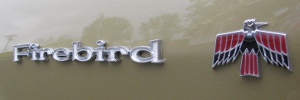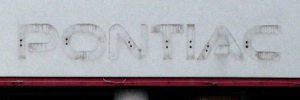















Pontiac Firebird |
|---|


|
| External Links |
|---|
| Wikipedia: Pontiac Firebird |
| Subtopics |
|
1967, 1968
Pontiac Trans Am 
Boogie Bird 
Firebird City 
Firehawk: Fiercest of the Firebirds |
| Page Sections |
|
History
Cultural References Bibliography Photographs Video Documents Merchandise Article Index |
History
The following section is an excerpt from Wikipedia's Pontiac Firebird page on 13 April 2016, text available via the Creative Commons Attribution-ShareAlike 3.0 Unported License.
The Pontiac Firebird is an automobile that was built by Pontiac from the 1967 to the 2002 model years. The Firebird was introduced the same year as the automaker's platform-sharing model, the Chevrolet Camaro. This coincided with the release of the 1967 Mercury Cougar, which shared its platform with another pony car, the Ford Mustang.
The name "Firebird" was also previously used by Pontiac's parent company General Motors for the General Motors Firebird 1950s and early-1960s concept cars.
First generation (1967–1969)
The first generation Firebirds had a characteristic Coke bottle styling. Unlike its cousin the Chevrolet Camaro, the Firebird's bumpers were integrated into the design of the front end. The Firebird's rear "slit" taillights were inspired by the Pontiac GTO. Both a two-door hardtop and a convertible were offered through the 1969 model year. Originally, the car was a "consolation prize" for Pontiac, who had wished to produce a two-seat sports car of its own design, based on the original Banshee concept car. However, GM feared such a vehicle would directly compete with Chevrolet's Corvette, and the decision was made to give Pontiac a piece of the pony car market by having them share the F-body platform with Chevrolet.
Second generation (1970–1981)
The second generation debut for the 1970 model year was delayed until February 26, 1970, because of tooling and engineering problems; thus, its popular designation as a 1970½ model, while leftover 1969s were listed in early Pontiac literature without a model-year identification. This generation of Firebirds were available in coupe form only; convertibles disappeared after the 1969 model year.
Replacing the "Coke bottle" styling was a more "swoopy" body style, while still retaining some traditional elements. The top of the rear window line going almost straight down to the lip of the trunk lid, a look that was to epitomize F-body styling for the longest period during the Firebird's lifetime. The new design was initially characterized with a large C-pillar, until 1975 when the rear window was enlarged.
Third generation (1982–1992)
The availability and cost of gasoline (two fuel crises had occurred by this time) meant the weight and the fuel consumption of the 3rd generation had to be considered in the design. In F-body development, both the third generation Firebird and Camaro were proposed as possible front wheel drive platforms, but the idea was scrapped. The state of the art of computerized engine management was in its infancy, and as long as saving fuel was the primary objective, it was not possible to have high horsepower and torque numbers. They did manage to cut enough weight from the design so that acceleration performance would be better than the 1981 models. They also succeeded in the fuel consumption department, offering a 4-cylinder Firebird that would provide 34 miles per gallon. GM executives decided that engineering effort would best be spent on aerodynamics and chassis development. They created a modern platform, so that when engine technology advanced, they would have a well-balanced package with acceleration, braking, handling, and aerodynamics. For the time being, they would have world class aerodynamics and handling, and excellent fuel economy.
Fourth generation (1993–2002)
The fourth-generation Firebird amplified the aerodynamic styling initiated by the previous generation. While the live rear axle and floorpan aft of the front seats remained largely the same, ninety percent of the Firebird's parts were all-new. Overall, the styling of the Firebird more strongly reflected the Banshee IV concept car than the 1991 "facelift" did. As with the Camaro, major improvements included standard dual airbags, four-wheel anti-lock brakes, 16-inch wheels, rack-and-pinion power steering, short/long-arm front suspension, and several non-rusting composite body panels. Throughout its fourth generation, trim levels included V6-powered Firebird, and V8-powered Formula and Trans Am. The T5 five-speed manual transmission was standard with the V6s, as was the Borg-Warner T56 six-speed manual for the V8s. A four-speed automatic was optional for both, featuring built-in electronic controls beginning in 1994.
Cultural References
Pat Monahan (lead singer) drove a 1967 Firebird in the music video for the song "Drive By" by the band Train.
| Title & Subtitle | Details |
|---|---|
Pontiac Firebird & Trans Am 1970-1981 Shop Manual | Year & Type: 1981 Service Manual Editor: Alan Ahlstrand Publisher: Clymer Publications Dimensions: 7" x 10.175" softcover Content: 268 pages w/black & white illustrations Topics: Pontiac Firebird, Pontiac Trans Am Availability: Reference Desk |
1981 Pontiac Service Manual Pontiac, Grand Prix, LeMans and Firebird | Year & Type: 1981 Service Manual Publisher: General Motors Corporation Dimensions: 8.5" x 11" softcover Content: 800+ pages w/black & white illustrations Topics: Pontiac, Pontiac Grand Prix, Pontiac LeMans, Pontiac Firebird, and Pontiac Trans Am Availability: Reference Desk |
1995 Chevrolet Camaro and Pontiac Firebird Service Manual Book 1 of 2 | Year & Type: 1995 Service Manual Publisher: General Motors Corporation Dimensions: 8.5" x 11" softcover Content: 1,200+ pages w/black & white illustrations Topics: Chevrolet Camaro, Pontiac Firebird Availability: Reference Desk |
1995 Chevrolet Camaro and Pontiac Firebird Service Manual Book 2 of 2 | Year & Type: 1995 Service Manual Publisher: General Motors Corporation Dimensions: 8.5" x 11" softcover Content: 600+ pages w/black & white illustrations Topics: Chevrolet Camaro, Pontiac Firebird Availability: Reference Desk |
Firebird Formula Bye Run
2005 Poncho Show & Go
Video by "m2pmd70"
May 1, 2005
Download Firebird Formula Bye Run in MPEG1 format - 2,094KB
1969 GTO vs. Firebird Formula
2005 Poncho Show & Go
Video by "m2pmd70"
May 1, 2005
Download 1969 GTO vs. Firebird Formula in MPEG1 format - 8,899KB
1977 Trans Am vs. Firebird Formula Final Round
2005 Poncho Show & Go
Video by "m2pmd70"
May 1, 2005
Download 1977 Trans Am vs. Firebird Formula Final Round in MPEG1 format - 15,632KB
| Type & Item # | Name | Details |
|---|---|---|
| Model Kit - MPC 1-0822 | Sundancer '69 Firebird Convertible |  |
| Model Kit - MPC 1569-200 | 1969 Firebird Hardtop | 1:25 scale |
| Model Kit - MPC 6324 | 69 Firebird | 1:25 scale, 2 in 1 |
| Die Cast - Hot Wheels G6692-0715 (C4982) | 1969 Pontiac Firebird T/A | Realistix, small scale, white w/blue stripes |
| Die Cast - Hot Wheels J3426-0917D | 1969 Pontiac Firebird | Red Line, small scale, metallic pink w/Red Line tires |
| Die Cast - ExactDetail 401 | Tin Indian Pontiac Firebird 400 | 1:18 scale, production 3,000 |
| Die Cast - Hot Wheels R7639-0818 | Hot Bird | 1970's Pontiac Firebird, Race World Volcano, small scale, blue w/red flames (Short Card) |
| Model Kit - Revell 85-0807 | Firebird Street Machine | Custom 1970's Firebird, Motorworks, 1:25 scale |
| Model Kit - MPC 1-0761 | Indy Pace Car Turbo Firebird | 1981, 1:25 scale, Golden Wheels Bonus |
| Model Kit - MPC 1-0808 | Firebird | 1980's Firebird, 1:25 scale, Golden Opportunity Kit |
| Die Cast - Action 100426 | Alan Kulwicki #97 WLPX | 1983 Pontiac Firebird, Xtreme Series, 1:24 scale, production 3,792 (ARC 3,504/QVC 288) |
| Die Cast - Action 100431 | Alan Kulwicki #22 Miller | 1984 Pontiac Firebird, Xtreme Series, 1:24 scale, production 4,500 |
| Die Cast 2 Pack - kidconnection 15080-1601 | Pontiac Firebird/2006 Pontiac Solstice | Small scale, red Firebird & dark blue Solstice |
| Model Kit - Revell-Monogram 85-7636 | McDonald's Firebird Funny Car | 1:24 scale |
| Model Kit - Revell 85-2159 | '98 Pontiac Firebird Ram Air 2 'n 1 | Motor-City Muscle, 1:25 scale |
| Die Cast - Action 102782 | Dale Earnhardt #1 True Value | Dale Earnhardt Legendary Series, 1:24 scale, 1999 IROC Pontiac Firebird Xtreme, 2002 Series, production 39,156 |
| Die Cast - Action 102785 | Dale Earnhardt, Jr. #11 True Value | 1:24 scale, 1999 IROC Pontiac Firebird Xtreme, 2002 Series, production 33,876 |
| Model Kit 3 Pack - Monogram 6241 | Pontiac Muscle Cars (Pontiac Firebird, Pontiac GTO, Pro-Street Firebird) | 1:24 scale, Kay-Bee Special Value Tri-Pack: 1978 Trans Am, 1964 Pontiac GTO, 1980's Firebird Pro Street |
